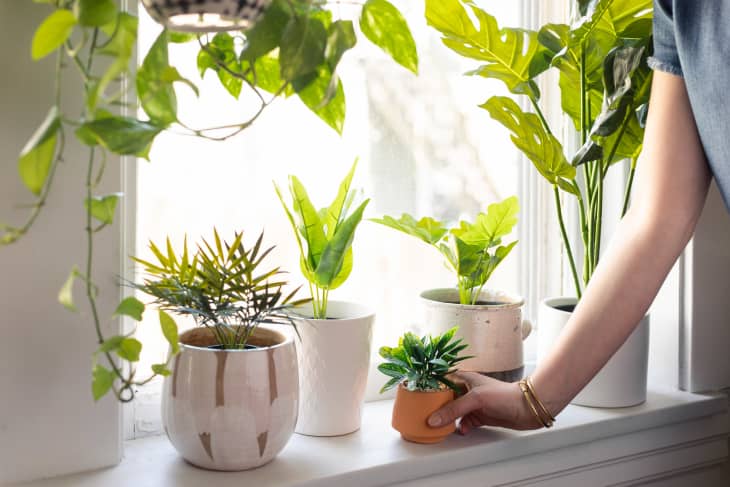What to Do if Your Plants are Exposed to an Unexpected Cold Snap
No surprise here: When it comes to weather, most indoor and outdoor plants prefer the hot days of summer to the cold chill of winter. But sometimes things happen — like anunexpected (and unprecedented) winter storm, a mail-order plant that was left out on the porch for too long, or even just a planter left by an especially drafty window. You might think that plants that have been exposed to extreme cold are goners, but there are a few steps you can take that might help revive your struggling greenery.
Of course, the best method for protecting both outdoor plants and houseplants in cold winter months is to implement preventative measures. For houseplants, make sure your windows are sealed and you’ve moved all your plants away from chilly drafts and the cold window panes. Also, keep those houseplants away from doors that open to the outside. For your outdoor gardens, add extra mulch around perennials and consider using frost cloth if the forecast is looking unfavorable for sensitive plants in your agricultural zone.
If your plants have already been exposed to cold temperatures, there could still be hope. The following tips might not prove successful in every scenario, but it’s a good place to start.
What to Do for Cold-Exposed Houseplants
You have to remember that most common houseplants are tropical, and a lot of them are extremely sensitive to temperatures under 50 degrees Fahrenheit. Some will start dying the second the temps dip, but others can regenerate from healthy roots below the soil even if the top part of the plant is completely frozen.
An important factor in the chance of survival is how long the plants were exposed to cold temperatures. A few hours can do the job, depending on the plant. Generally, though, it takes 12 to 24 hours of exposure to cold temperatures to completely kill most tropical plant species.
If you’re in doubt, check the roots. If they’re white and firm, you’re good to go. If they’re mushy, your plant won’t be able to make a comeback. The roots may also be somewhere in between — and if that’s the case, you should give revival a chance with the following tips.
1. Get the plant to warmer temperatures as soon as you can.
Bring the plant into a warmer area as soon as possible. Don’t go about cutting off any foliage that looks dead — simply concentrate on getting the plant warm. The recovery process will start (depending on the length of cold exposure) as soon as it warms up.Don’t try to accelerate the process by placing it on a radiator or heating element.Let it happen naturally.
2. Water right away.
给植物少量的水and let it drain out of the container. When plants freeze, the moisture gets sucked from the leaf tissue — which is a huge problem because plants need hydration in order to live. As the plant tries to recover, water as you normally would.
3. Skip fertilizer.
Do not fertilize. You risk damaging the plant tissues during this recovery phase. Instead, leave your plant to recover alone.
4. Later, prune dead foliage.
Cut off all dead blooms and foliage, but not until after the plant has been “warm” for at least a month. The plant needs time to regenerate energy, so give it some space.
What to Do for Cold-Exposed Outdoor Gardens
Unlike with most houseplants, outdoor gardens are typically planted with zone-appropriate plants that have a good chance of recovering from a brutal cold snap.
After temperature drop to 32 degrees Fahrenheit and lower, frost forms on the ground from water vapor that has condensed and frozen. As the cold air hits the leaves of actively growing plants, the water inside the leaves freeze — just like with houseplants. This damages the plant cells and therefore damages the plant.
You’ll be able to tell when your garden is suffering after a cold snap. Leaves will curl, drop, or change color — usually from a green to a white, yellow, black, or brown. Here’s what to do to try to maximize recovery for your outdoor plants.
1. Leave the plants be… for now.
At first, leave your plants alone. It can be very, very tempting to run out after the frost or snow melts off your garden. In general, it can be hard to see what damage has been done until the plants try to generate new growth. You’ll find that snow is a good insulator from extremely cold temps — and sometimes it can work in your favor.
2. Bring potted plants inside.
If you have potted plants outdoors, bring them inside and follow the directions for the houseplants, above.
3. Protect sensitive plants.
If the forecast calls for more cold temps, it’s a good idea to try to protect sensitive plants with frost cloth to prevent more damage.
4. After things warm up, get back to normal.
Once the temperatures warm, begin your typical watering routine. Just like tropical houseplants, outdoor garden plants need water to begin the regeneration process.
5. Don’t fertilize.
As with tropical houseplants, do not fertilize until the plant has fully recovered.
Unfortunately, you’ll know if they’re completely dead if you leave them alone for a month or two and they do not begin to show signs of new growth. With plants, you win some and you lose some in the long run. The longer you garden or keep a houseplant collection, the more you’ll learn.

